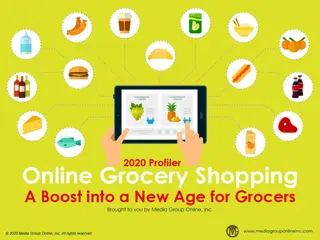Shopping Behavior and Attitudes during the Transition Phase of the COVID-19 Pandemic
Investigating shopping patterns and attitudes during the transition phase of the COVID-19 pandemic reveals shifts towards online shopping, changes in shopping frequencies, and purchase patterns. The study shows a mix of in-store and online shopping preferences, with variations in shopping activities and expenditures. Overall, there is a noticeable impact on consumer behavior in response to the pandemic.
Download Presentation

Please find below an Image/Link to download the presentation.
The content on the website is provided AS IS for your information and personal use only. It may not be sold, licensed, or shared on other websites without obtaining consent from the author.If you encounter any issues during the download, it is possible that the publisher has removed the file from their server.
You are allowed to download the files provided on this website for personal or commercial use, subject to the condition that they are used lawfully. All files are the property of their respective owners.
The content on the website is provided AS IS for your information and personal use only. It may not be sold, licensed, or shared on other websites without obtaining consent from the author.
E N D
Presentation Transcript
Shopping Behavior and Attitudes during the Transition Phase (to normalcy) of the COVID- 19 Pandemic By Ibukun Titiloye Feb 22, 2022 1
Purpose Understand shopping patterns during the Pandemic Two waves of data collection Jan-Feb 2021 (Early Transition) Oct-Nov 2021 (Back to Normal ?) Online vs. In-store 2
Shopping behavior between Oct - Nov 2021 (1,747) Shopping behavior between Jan - Feb 2021 (2,257) Shopping Frequency for Online and In-store 3
Shopping Activities Before COVID-19 100% 90% 80% 70% 60% 50% 40% More than 60% never ordered groceries for pick up or delivery before; about 10% more adopted grocery delivery during COVID-19. 30% 20% 10% 0% IN STORE PICK UP DELIVERY IN RESTURANT PICK UP DELIVERY DELIVERY GROCERY SHOPPING FOOD/MEAL OTHER ITEMS Never Once every month or less Once every two weeks Once every week A few times a week Every day In-restaurant food/meal saw the largest impact, about 65% hadn t gone into a restaurant compared to 10% before the outbreak. Shopping Activities during COVID-19 100% 90% 80% 70% 60% 50% 40% 30% 20% 10% 0% IN STORE PICK UP DELIVERY IN RESTURANT PICK UP DELIVERY DELIVERY May 2020 Shopping Behavior GROCERY SHOPPING FOOD/MEAL OTHER ITEMS Never Once every month or less Once every two weeks Once every week A few times a week Every day 4
Shift in Online Shopping More people adopted online shopping for groceries at the beginning of the outbreak; part of the effect remains and has stabilized. Most people still went grocery shopping in stores, with less frequency at the beginning, but has returned to pre-pandemic condition. Online shopping for other items has seen slight increase in frequency during the pandemic. 5
Purchase pattern People tended to shop online more often for CSWJ and BH than other products In-store shopping for grocery and prepared food was the dominant mode for most people In-store shopping frequency slightly exceeded online shopping frequency in general, except for BE. 6
Purchase expenditure Shoppers spent slightly more money for the same product categories online than in-store, except for grocery items 7
Travel distance to store People were more willing to travel further for CSWJ Grocery and prepared food purchases were more likely to be within shorter distances 8
Attitudes toward online vs. in-store shopping Shopping attitudes toward shopping method, technology, social interaction, data security, cost consciousness, time consciousness, convenience, the environment, mobility options, etc. Comparison between those who shopped online at least once (online shoppers) and those who did not shop online in the past month (in-store shoppers). Unweighted sample sizes for online shoppers and in-store shoppers were 1,971 and 286 observations, respectively. 9
1 2 Technology and Automation Online shoppers tended to be those who used phone apps1 and the Internet more2, and to have positive attitudes toward technology in general 10
2 Shopping method & social interaction 1 Online shoppers found online shopping more convenient1 Online shoppers were more likely to feel stressed from physical shopping2 People generally did not necessarily like talking to or meeting people in stores3 3 11
Data security 1 People generally trusted online shopping1 However, in-store shoppers were relatively less likely to trust online shopping and online stores websites and tended to be more concerned about putting in their personal information online 12
Cost-Consciousness & Time-Consciousness 1 People were generally price conscious, but that depends on how strongly the shopper wants the product1. 2 Online shoppers seemed to be more time conscious than in-store shoppers when choosing whether to shop online or in store2 (though they liked to take their time and shop multiple times before making their final purchase)3 3 13
Factors Discouraging Online Shopping Concerns over putting information online (privacy issues)1, shipping costs 2, and return process 3 were top factors discouraging online shopping 2 3 1 14
Factors Encouraging Online Shopping Comparing products and their prices seem to be a big motivator of using online shopping 15
Conclusions For the same product types, people tended to spend more money shopping online than in-store (except for grocery items), however they tended to shop more frequently in-store than online (except for BE) People were more likely to shop more frequently online and were more willing to travel long distances for CSWJ Although in-store shopping for grocery and prepared food were the dominant activities for most shoppers, they tended to be within relatively shorter distances Generally, both online and in-store shoppers trusted online shopping, liked purchasing from local stores, and did not necessarily like social interaction in stores However, online shoppers tended to use technology more and have positive attitudes toward technology, and were more influenced by time factor in choosing whether to shop online or in a store In-store shoppers tended to be more concerned about putting in their personal information online, and were less likely to like unattended deliveries, curbside pickup or collecting items at a delivery point Overall, comparing products and their prices seem to be a big motivator in using online shopping 16























